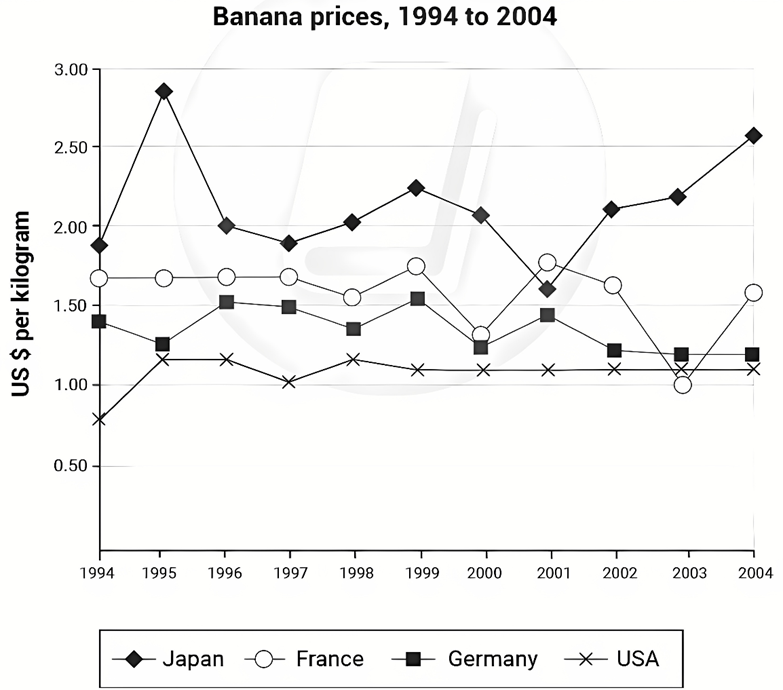Câu hỏi:
11/01/2025 180
The graph below gives information about the price of bananas in four countries between 1994 and 2004.
Summarise the information by selecting and reporting the main features, and make comparisons where relevant. Write at least 150 words.
The graph below gives information about the price of bananas in four countries between 1994 and 2004.
Summarise the information by selecting and reporting the main features, and make comparisons where relevant. Write at least 150 words.
Câu hỏi trong đề: 2000 câu trắc nghiệm tổng hợp Tiếng Anh 2025 có đáp án !!
Quảng cáo
Trả lời:

Sample 1:
The line graph shows how much bananas cost in four different nations from 1994 to 2004.
Overall, banana prices in all countries experienced wild fluctuations, except for the USA, whose figure remained relatively stable for the majority of the period. Additionally, bananas were generally the most and least expensive in Japan and the USA, respectively.
Regading Japan, the cost of a kilogram of bananas started at nearly 2 US dollars, after which it had risen sharply to peak at around 2.8 by 1995. Despite an increase between 1997 and 1999, the banana price in Japan dropped to a low of just above 1.5 US dollars per kilogram before rebounding to end at 2.5. Bananas in the USA, meanwhile, were initially priced at about 0.7 US dollars. This was followed by a rise to approximately 1.1 one year later and a leveling off towards the end of the timeframe.
Turning to France, there was a period of stability in the price of bananas, remaining at roughly 1.7 US dollars per kilogram from 1994 to 1997. Thereafter, the figure fluctuated wildly, with it becoming the highest in the chart in 2001 (at 1.7)andthelowestin2003(at1.7)andthelowestin2003(at1) prior to reaching just over 1.5 in 2004. The banana costs in Germany almost exactly mirrored this fluctuating trend, hovering around the 1.4 US dollar mark in the first seven years and then falling gradually to about 1.2 in 2004.
Sample 2:
The line chart compares the cost of bananas in Japan, France, Germany and the USA from 1994 to 2004.
Overall, bananas were the most expensive in Japan and cheapest in the USA. In addition, the prices in all nations were erratic over the period, with the exception of the USA.
In Japan, the cost of bananas increased dramatically from about 1.80/kgin1994toapeakofaround1.80/kgin1994toapeakofaround2.80/kg in 1995, but then decreased to approximately 2.00/kgin1996.Afterhoveringbetween2.00/kgin1996.Afterhoveringbetween1.80/kg and 2.30/kgfrom1997to2000,thepricedeclinedtonearly2.30/kgfrom1997to2000,thepricedeclinedtonearly1.50/kg in 2001 before rising to about 2.50/kgin2004.Incontrast,afteraninitialincrease,thecostofbananasintheUSAstabilizedataround2.50/kgin2004.Incontrast,afteraninitialincrease,thecostofbananasintheUSAstabilizedataround1.20/kg until 2004.
France and Germany witnessed a similar pattern over the entire period, with the prices returning to almost their original values despite fluctuations, at about 1.40/kgand1.40/kgand1.70/kg respectively. While banana prices in Germany declined gradually to around 1.10/kgin2004,thefiguresforFrancefluctuatedwildly,overtakingJapantobecomethecountrywithhighestprice(around1.10/kgin2004,thefiguresforFrancefluctuatedwildly,overtakingJapantobecomethecountrywithhighestprice(around1.80/kg) in 200. They then hit a trough of around 1.00/kg,thelowestamong4countriesin2003andfinallyreachedjustover1.00/kg,thelowestamong4countriesin2003andfinallyreachedjustover1.50/kg in 2004.
Sample 3:
The given line graph compares how much bananas cost in 4 different countries: Japan, France, Germany, and the USA from 1994 to 2004.
Overall, the prices of bananas were the highest in Japan and the lowest in America. Furthermore, except for the USA, bananas’ costs in all the countries fluctuated wildly over the ten-year period, with France and Germany following a relatively similar trend.
Regarding Japan, starting at 1.80/kgin1994,thepricehitapeakof1.80/kgin1994,thepricehitapeakof2.80 in the next year, before dropping to 2.0in1996.Fromthisyearonwardsto2000,bananas′costoscillatedbetween1.90 and 2.20andhitabottomofaround1.50 in 2001. This was followed by a rebound to 2.10oneyearlater,whenthecostroseexponentiallyto2.50 at the end of the period. The price of bananas in America remained stable at around 1.10throughoutthetenyearsafteranincreasefrom0.70 in 1994.
Both France and Germany started at 1.60and1.40, respectively, but while France’s price stabilized until 1997, Germany’s cost saw a plunge to 1.20in1996.From1997to2004,thetwocountries′costsexperienceddramaticfluctuations,especiallyinFrance,wherethepricewasmoreexpensivethanJapanin2001at1.60 and the lowest of all countries in 2003 at $1.00. However, in the end, bananas cost roughly the same as they did 10 years prior in both countries.
Sample 4:
The provided line graph illustrates the price fluctuations of bananas in four distinct countries: Japan, France, Germany, and the USA from 1994 to 2004.
Overall, Japan consistently held the highest banana prices, while the USA maintained the lowest prices. Additionally, barring the USA, all countries witnessed significant price variations over the ten-year period.
In Japan, the banana cost initiated at 1.80/kgin1994,peakedat2.80 in the subsequent year, and then declined to 2.00by1996.From1996to2000,pricesoscillatedbetween1.90 and 2.20beforedippingtoapproximately1.50 in 2001. Thereafter, prices surged to 2.10inthefollowingyearandnotablyescalatedto2.50 by the end of the period. Conversely, the price of bananas in America remained relatively steady, hovering around 1.10throughouttheentiredecadeafteranincreasefrom0.70 in 1994.
France and Germany commenced at 1.60and1.40, respectively. However, the former remained relatively stable until 1997, whereas the latter varied between 1.20and1.50. Subsequently, both countries followed a relatively similar fluctuating trend, but since 2002, while France plunged to a low of 1.00beforeapartialrecoveryto1.60 by the conclusion of the period, Germany stayed almost unaltered at around $1.25.
Sample 5:
The line chart compares banana prices in four nations from 1994 to 2004. Overall, Japan and the USA saw an increase in their bananas' prices, while the reverse was true for France and Germany. Notably, bananas from Japan remained relatively the most expensive, while those from the USA were almost always the cheapest.
In terms of Japan and the USA, the former had the most volatile trend, starting highest at nearly US2perkilogram.Despitepeakingatabout2.7 the following year, the figure dropped to 2in1996.In2001,thebananapriceinJapanfellagain,reachinganadirofjustoverUS1.5 per kilogram. However, it surged from 2001 onwards, and by 2004, it had risen to 2.5.Incomparison,bananasintheUSAweremuchcheaper,onlyincreasingfromthestartofroughly0.7 to about $1.3 in 1995. Towards the end of the period, the price stayed almost the same.
With bananas in the other two countries, the price in France was stable at around US1.6perkilogramfrom1994to1999.Butfromthereonwards,thefiguredroppedtoabout1.3 in 2000 and fell again in 2003, reaching the lowest point of 1.However,itrecoveredimmediatelytofinishatslightlyabove1.5. Compared to banana prices in Germany, these were more stable, ranging from approximately 1.2to1.5. By the end of the period, the price had decreased by only roughly 0.2fromthestartingpriceofapproximately1.4.
Sample 6:
The provided line graph illustrates how many bananas were in four countries over a period of ten years, starting from 1994.
Overall, it took Japanese people more money to purchase a kilogram of bananas than their counterparts in the other two countries in almost all the years examined. In addition, the prices of this item in all four countries experienced fluctuations, the mildest of which was observed in the figure for the USA.
Regarding the USA and Germany. At the beginning of the period, Bananas in the former cost around 0,8perkilogram,whichwassignificantlyhigherthanthefigureforthelatter,atabout1.9. After that, the banana price in Germany fluctuated downward until 2002 and remained the same at 1.3fromthento2004.Meanwhile,peopleintheUSAhadtospendthesameamountofmoneyforakilogramofbananas,atapproximately1.2, in six consecutive years, from 1998 to 2004.
People in France needed to spend around 1,7forakilogramofbananasfrom1994to1997.Subsequently,thisfigurefluctuatedatincreasinglevelsyearafteryearbeforeendingat1.6. Compared to France, the figure for Japan started at roughly 1.8andsurgednotablyuntilpeakingat2.8 one year later. However, the banana price in this country fell sharply soon after that and hit the lowest point of 1.6in2001despitesomeincreasesbetween1998to2000.Finally,thisfigurerecoveredbackto2.6 at the end of the period.
Sample 7:
The line graph compares the price of bananas across four different nations in the world, namely Japan, France, Germany, and the USA from 1994 to 2004.
Two contrasting trends in the banana price are revealed, with Japan and America reporting a general upswing, while France and Germany a downswing. Bananas had the highest value on the Japanese market, contrary to German and American markets where this fruit was of a low price.
Initially, a Japanese citizen had to pay the highest amount of money for a kilogram of bananas (around 1.80).Thisnumberinflatedtoahighof2.80 in 1995, but then decreased and hovered around the 1994 figure till 2000. 1.40perkilogramwasthebananapriceinFrancein1994,whichremainedunchangedtill1997beforefallingtojustabout1.30 in 2000.
In 2001, however, France eclipsed Japan as the country with the most expensive bananas, peaking at about 1.70.However,thisleadwasshort−lived,asthebananapriceinJapansoaredagainto2.50 in 2004, while that of France fell to a low of below 1.00in2003andrecoveredtoonlyover1.50 one year later.
In Germany, a kilogram of bananas cost less than 1.50in1994,whichwasnotascheapasintheUSAatjustaround0.80. The figure for the European country fluctuated within the range of 1.25to1.50 until 2001 before dropping gradually to a low of about 1.20in2004.InAmerica,thepricerosetoapproximately1.20 in 1995, oscillated slightly till 1999 and then stabilized at just over $1.00 in the end.
Hot: 500+ Đề thi thử tốt nghiệp THPT các môn, ĐGNL các trường ĐH... file word có đáp án (2025). Tải ngay

Sổ tay lớp 12 các môn Toán, Lí, Hóa, Văn, Sử, Địa, KTPL (chương trình mới)
Đã bán 1,5k

Tổng ôn lớp 12 môn Toán, Lí, Hóa, Văn, Anh, Sinh Sử, Địa, KTPL (Form 2025)
Đã bán 1,1k
Bình luận
CÂU HỎI HOT CÙNG CHỦ ĐỀ
Câu 1:
Some people think that all teenagers should be required to do unpaid work in their free time to help the local community. They believe this would benefit both the individual teenager and society as a whole. Do you agree or disagree?
Câu 2:
The charts below show the water levels of 6 cities in Australia in October 2009 and 2010.
Summarise the information by selecting and reporting the main features, and make comparisons where relevant. Write at least 150 words.
The charts below show the water levels of 6 cities in Australia in October 2009 and 2010.
Summarise the information by selecting and reporting the main features, and make comparisons where relevant. Write at least 150 words.
Câu 3:
The diagram below shows a small local museum and its surroundings in 1957 and 2007.
Summarize the information by selecting and reporting the main features, and make comparisons where relevant. Write at least 150 words.
The diagram below shows a small local museum and its surroundings in 1957 and 2007.
Summarize the information by selecting and reporting the main features, and make comparisons where relevant. Write at least 150 words.
Câu 4:
It is better for college students to live in schools than live at home with their parents. Do you agree or disagree?
It is better for college students to live in schools than live at home with their parents. Do you agree or disagree?
Câu 5:
Some people prefer to live in a small town. Others prefer to live in a big city. Which place would you prefer to live in? Use specific reasons and details to support your answer.
Câu 6:
Smoking not only harms the smoker, but also those who are nearby. Therefore, smoking should be banned in public places. To what extent do you agree or disagree?
Câu 7:
Although there is a lot of translation software available, learning a language still could be advantageous. To what extent do you agree or disagree?
Although there is a lot of translation software available, learning a language still could be advantageous. To what extent do you agree or disagree?

🔥 Đề thi HOT:
-
Bộ câu hỏi: [TEST] Từ loại (Buổi 1) (Có đáp án)
-
Bài tập chức năng giao tiếp (Có đáp án)
-
500 bài Đọc điền ôn thi Tiếng anh lớp 12 có đáp án (Đề 1)
-
Bộ câu hỏi: Các dạng thức của động từ (to v - v-ing) (Có đáp án)
-
Đề kiểm tra học kì 2 Tiếng anh 12 năm 2023 có đáp án (Đề 28)
-
Trắc nghiệm Tiếng anh 12 Tìm từ được gạch chân phát âm khác - Mức độ nhận biết có đáp án
-
15000 bài tập tách từ đề thi thử môn Tiếng Anh có đáp án (Phần 1)
-
Bộ câu hỏi: Thì và sự phối thì (Phần 2) (Có đáp án)


Hãy Đăng nhập hoặc Tạo tài khoản để gửi bình luận
-
-
Bình luận